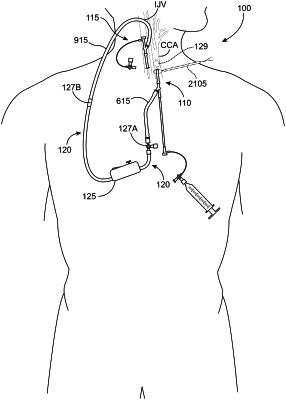| CPC A61F 2/014 (2020.05) [A61B 17/12 (2013.01); A61F 2/954 (2013.01); A61M 25/0032 (2013.01); A61M 25/09 (2013.01); A61M 2025/0008 (2013.01); A61M 2025/0681 (2013.01); A61M 2025/1052 (2013.01)] | 10 Claims |

|
1. A method for treating a carotid artery, comprising:
positioning an arterial access device having a distal sheath into a common carotid artery through an access location in a neck of a patient, the arterial access device comprising:
a distal sheath adapted to be introduced into a carotid artery through a wall of the carotid artery, the sheath having a lumen extending between a distal opening and a proximal opening;
wherein the distal sheath includes a material that defines a plurality of spaces evenly distributed and uninterrupted along at least a portion of a length of the distal sheath; and
wherein the distal sheath includes at least one fenestration aligned with at least one of the spaces defined by the material;
occluding blood flow at an occlusion location of the common carotid artery to establish retrograde blood flow through the common carotid artery such that blood flows into the lumen of the arterial access device, wherein the occlusion location is located proximal of the distal opening so as to form a zone between the occlusion location and the distal opening;
wherein the blood flows into the distal sheath via at least one of the distal opening and the at least one fenestration.
|